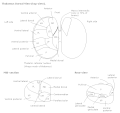You can help expand this article with text translated from the corresponding article in Italian. (November 2025)Click [show] for important translation instructions.
|
| Centromedian nucleus | |
|---|---|
 Centromedian nucleus inside left thalamus | |
| Details | |
| Part of | Intralaminar thalamic nuclei |
| Identifiers | |
| Latin | nucleus centromedianus thalami |
| Acronym | CM or Cm-Pf |
| NeuroNames | 323 |
| NeuroLex ID | birnlex_805 |
| TA98 | A14.1.08.618 |
| FMA | 62165 |
| Anatomical terms of neuroanatomy | |
In the anatomy of the brain, the centromedian nucleus, also known as the centrum medianum, (CM or Cm-Pf) is a nucleus in the posterior group of the intralaminar thalamic nuclei (ITN) in the thalamus. (This must not be confused with the central medial nucleus, which is in the anterior group of the ITN.) There are two centromedian nuclei arranged bilaterally.
Contents
In humans, each centromedian nucleus contains about 2200 neurons per cubic millimetre and has a volume of about 310 cubic millimetres with 664,000 neurons in total. [1] It measures less than 10 millimetres in every dimension. [2] It belongs to the caudal intralaminar group of thalamic nuclei and is situated within the medial thalamus. It is bordered superiorly by the mediodorsal nucleus, medially by the parafascicular nucleus, and posteriorly by the pulvinar. [2] [3]

